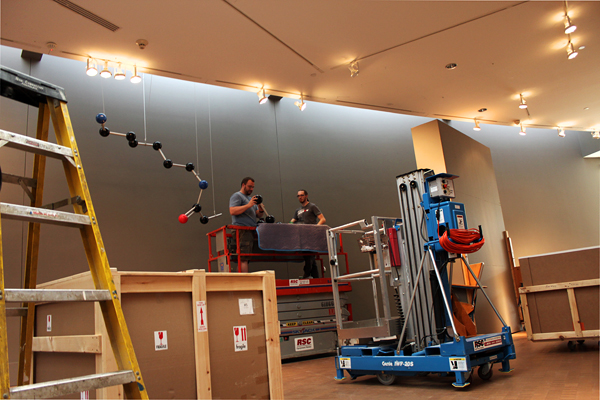Many Grinnell College students with a shared passion for art Aspirin, Isooctane, Penicillin G, Polyethylene, Nylon 6.6, DNA, Progestin, DDT, Prozac and Buckyball and Carbon Nanotubes are all making an unusual, artistic, appearance in Faulconer Ga

llery.
Molecules That Matter opens today in Faulconer Gallery. Brought to Grinnell from the Frances Young Tang Teaching Museum at Skidmore College, this unique exhibition blends sculptures, paintings, models and photos throughout the space to tell the story of 10 molecules that changed the face of the 20th century.
The exhibit follows a progression through the decades—individual space is devoted to each compound, centered upon giant models of the chemical makeup. The rods and spheres of the molecules are surrounded by related artwork.
Molecules That Matter is intended to reach across various subjects.
“You can say this about art you can say this is about science but it’s also about ethics and it’s also about social sciences and history,” Tilly Woodward, Curator of Academic and Community Outreach at Faulconer, said.
Essentially, the show aims to achieve a balance between what is aesthetic and what is ethical—a difficult line to tread.
One of the pieces, by Fred Tomaselli, is comprised of 13,000 Aspirin tablets glued to a back wood panel.
“I’d hate for people to go up to that and see just Aspirin and think, ‘Oh, this is just about Aspirin and not necessarily about human consumption or experience or interaction with the world,’” Andrew Kaufman, Art, said.
With this qualm in mind, Kaufman and Donna Stack, Art, will focus on bringing the inherently artistic nature of Molecules That Matter to the floor with their lecture on Oct. 14: Art That Matters.
“I’m able to privilege the art over the more scientific aspect,” Stack said. “[The audience will be] able to walk away and understand more clearly why a specific piece was chosen.”
“[The lecture] will reintroduce the idea of the content of that piece, really looking at it in a different way,” Kaufman said.
The show is intended to celebrate art and science in an interdisciplinary manner—yet it is this combination of art and science that has raised questions.
“What’s the result of juxtaposing these things together?” Kaufman said. The answer may be, unfortunately, less appreciation and examination of the actual art, in favor of a focus upon the chemistry.
“I question if this is collaborative or interdisciplinary, or if this is just a different way to get information across,” Kaufman said.
The catalog produced by the Tang about Molecules That Matter is entirely science-oriented. “All the images are just sort of illustrative [of the science]…nothing in this text reflects how this image is a collaboration…So for us it was a little disappointing and confusing, not having that spelled out,” Stack said.
Ironically, it was the collaboration between science and art that brought the exhibition from Skidmore to Grinnell.
“The primary reason is that it is an intensely interdisciplinary show and we’ve been working to find ways to reach out across the campus with our exhibitions,” Lesley Wright, the Director of Faulconer Gallery, said.
In an effort to support the show’s interdisciplinary aims, Kaufman and Stack plan to examine Molecules That Matter as an explicitly artistic exhibit. “[We will be] trying to re-contextualize the whole event paying critical attention to how the show was generated… how was it labeled and how should it be labeled and then try to place these artworks outside of the show and reintroduce some of the content that might not have been thought about,” said Kaufman.
Faulconer Gallery shares this focus on the art in Molecules That Matter. Woodward contacted Kaufman and Stack to put together their lecture and the gallery has produced a collection of information about the art and artists.
“We’ve put together a big binder of information about all the artists in the show because the catalog is very thorough about the molecule, but doesn’t show as much about the art,” Wright said.
The actual design of the exhibition is also aimed at highlighting the art. Milton Severe, the exhibit designer, noticed that in other installations of Molecules That Matter, the art had been more in the background. “The art sort of got lost, seemed a little incidental,” Severe said.
At Grinnell’s installation, he worked to avoid just that phenomenon. “One of my main considerations in laying it out was to separate out the non-art stuff in order to give the actual works of art space to breath.”
Faulconer Gallery’s twist on Molecules That Matter may be enough to engage viewers in the science and the art. Enough, even, to solidify the balanced, interdisciplinary nature of the show. In many ways, the final judgment rests firmly in the viewer’s hands. “[A]ll you need to do is come in and let it be what it is,” Severe said. “Just enjoy.”


















































